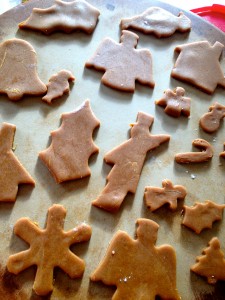Gingerbread is a favorite and common Christmas recipe in most households during the holiday season. It’s fun to make, fun to decorate and of course delicious!
When we went sugar free I was unsure how to make sugar free gingerbread cookies, as it seemed silly to make and decorate them, then not eat them. I had found a website with sugar free recipes that offered an alternative but when I tried it though it was edible, it was not the same and I decided that I would not make it again. Matthew though really liked them, which I thought was interesting.
This past summer, I started using barley malt and coconut sugar more. Barley malt is a great substitute for molasses and coconut sugar for brown sugar. I made a delicious baked bean recipe when we went camping using the barley malt in place of the molasses, oh it was yummy!
Once I discovered these substitutions and that they worked well, I took a look at my original gingerbread recipe and realized that I now had the appropriate substitutions to adjust this recipe. I was very excited!
 So I tried it out last week for the first time. I got out all my Christmas cookie cutters, which I have many, big and small and all different shapes. The kids love to use the cookie cutters and enjoy making the shapes. We made Santas, reindeer, angels and bells. Hollies and wreaths, snowmen and tin soldiers. Luke and Chloe were very excited and once we had them in the oven, asked to have the oven light on so they could see the cookies.
So I tried it out last week for the first time. I got out all my Christmas cookie cutters, which I have many, big and small and all different shapes. The kids love to use the cookie cutters and enjoy making the shapes. We made Santas, reindeer, angels and bells. Hollies and wreaths, snowmen and tin soldiers. Luke and Chloe were very excited and once we had them in the oven, asked to have the oven light on so they could see the cookies.
They did not eat much for lunch that day as they were waiting for cookies! (but I also used it an incentive to finish their lunch 🙂 They gobbled them up and of course wanted more, but after a few I said we would wait until later, as I actually had to bake the rest.
In adjusting the recipe I found that I would increase the spices a little, so though I have posted the recipe with the spice amounts as is, I would recommend increasing the ginger and maybe the cinnamon by 1/4 tsp. each, but it depends on your personal preference. I like my gingerbread cookies to be a bit more gingery than they turned out, though they were still very good.
We did not ice them this time around as we enjoyed them straight from the oven, but you could ice them with the recipe that I have included below. It is a basic sugar free icing recipe, which you can color using food coloring if you like. (Though food coloring is not good for us due to all the processing and effects it has on our body. You can buy natural food coloring in the store, I have seen it at Community Natural Foods here in Calgary, but you can also make your own. My sister has been experimenting with beets, spinach and other foods to color her icing for her cookies. More on that coming…)
Sugar Free Gingerbread Cookies
2 1/2 c. flour
1/2 c. coconut sugar
1/2 c. barley malt
1 egg, beaten
1 tsp. ginger or 1-2 drops Ginger essential oil
1/4 tsp. cinnamon or 1 drop Cinnamon Bark essential oil
1/8 tsp. cloves or 1-2 drops Clove Bud essential oil
1/2 tsp. baking soda
1 tbsp. hot water
1 tsp. vinegar
Sift flour, measure, resift. Cream shortening, blend in coconut sugar and add barley malt and beaten egg. Beat well. Mix spices with baking soda and blend until smooth with hot water and vinegar. Stir into creamed mixture. Add flour and mix.
Roll out dough on a well floured surface to 1/4″ thick. Dough may be quite sticky. Use cookie cutters to make desired shapes. Put on cookie sheet. Bake at 375 F for 10 minutes.
Cookies may be iced after fully cooled.
1 c. Powdered Sugar Replacement (see recipe below)
1/2 c. Earth Balance Vegan Spread
1/2 c. Rice Milk or Almond Milk
Put all ingredients in a bowl and mix together until smooth. Proportions can be adjusted to make icing thicker or thinner as desired. Add food coloring if desired, ice cookies.
Sugar Free Powdered Sugar (replacement for regular icing sugar)
1 cup nonfat dry milk (for dairy free use powdered coconut milk)
1 cup cornstarch
2/3 cup Krisda Stevia for baking
Combine all the ingredients in a food processor or blender and whip until blended and powdered. Store in an airtight container.
This replacement can be used in any recipe calling for icing sugar.








